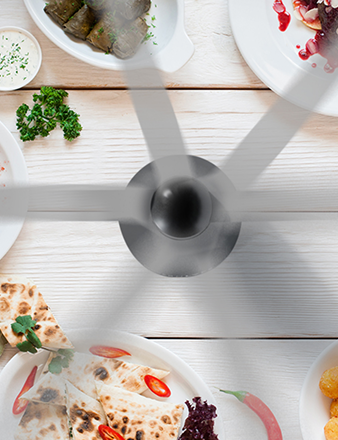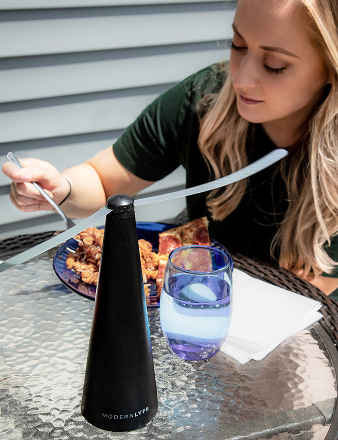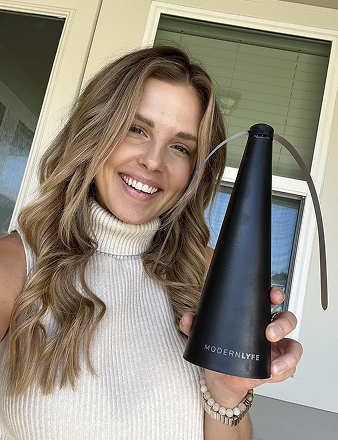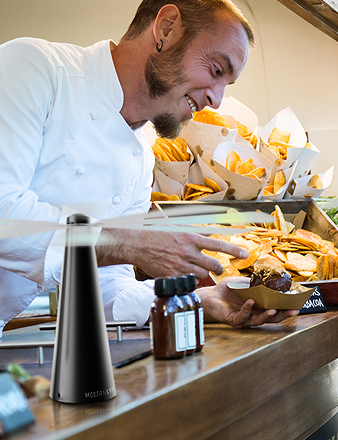You’ve seen them humming quietly above the entrance to a restaurant or shop. These are over-door fly fans, and they’re more than just fans—they're powerful devices designed to create an invisible air barrier that blocks flies and other insects from getting inside.
Unlike a simple fan that circulates air, these units project a high-velocity stream of air straight down. This current acts as a shield, keeping pests out while letting people come and go without hassle.
The Invisible Shield: How Over Door Fly Fans Work

Imagine an invisible gatekeeper for your doorway, made entirely of moving air. That’s how an over door fly fan works. The core principle is simple: it generates a strong, downward-flowing curtain of air that most flying insects can't push through.
Think of a waterfall. You can walk through it, but a small leaf would be pushed away by the force. The constant, turbulent air stream from a fly fan is too much for lightweight insects like flies and mosquitoes, forcing them away from the entrance.
Creating the Air Barrier
How does it create this air shield? The technology is straightforward. A motor inside the unit, mounted above the door frame, powers specialized fans. These fans pull in air from inside and shoot it down through a directional nozzle.
This creates a uniform, high-velocity sheet of air covering the entire doorway. To be effective, the air stream must be strong enough to reach the floor, creating a seamless, non-chemical barrier that helps you maintain a clean, comfortable indoor space.
More Than Just Pest Control
While keeping bugs out is their main job, this invisible shield offers another key benefit: climate control. The constant downward airflow prevents indoor air from escaping and outside air from rushing in.
This directly impacts your energy bills:
- In the summer, it keeps cool, conditioned air inside, giving your AC a break.
- In the winter, it holds onto heated air, stopping it from escaping every time the door opens.
This dual functionality is why these systems are so popular. The U.S. ventilation fan market, which includes over door fly fans, was valued at USD 561.7 million in 2023 and is expected to keep growing. The demand is driven by a need for better air quality and energy-saving solutions in both businesses and homes.
The real value of an over door fly fan is its ability to solve multiple problems with one solution. It's a pest deterrent, an energy saver, and a way to improve comfort without chemicals or physical barriers.
When you break it down, it's clear why these devices are a practical investment. If you're still curious about their real-world performance, check out our guide on whether fly fans truly work.
Key Benefits at a Glance
Here’s a quick summary of the main advantages of an over door fly fan.
| Benefit | Description |
|---|---|
| Chemical-Free Pest Control | Creates a physical air barrier that stops insects without harmful sprays or chemicals. |
| Improved Hygiene | Keeps flies and other disease-carrying pests away from food prep areas, dining rooms, and homes. |
| Energy Savings | Helps maintain indoor temperatures by preventing conditioned or heated air from escaping. |
| Unobstructed Access | Allows easy entry and exit for people and deliveries without the hassle of a physical screen. |
| Enhanced Comfort | Reduces the annoyance of insects and helps keep dust, pollen, and fumes from entering. |
These fans are a simple, effective solution that tackles several common problems at once, making them a smart addition to any entryway.
Where Over Door Fly Fans Make a Difference
We've covered the "how," so let's talk about the "where." Where does an over door fly fan become an absolute must-have? You'll find them most valuable in places where cleanliness, customer comfort, and smooth operations are non-negotiable.
Picture a popular café with a sunny patio. You don't want customers shooing away flies instead of enjoying their lattes. This is exactly where these fans become silent heroes, creating an invisible shield that keeps the experience pleasant.
Critical Environments for Fly Fan Success
While applications vary, the mission is the same: keep the inside clean and inviting. For any food business, understanding commercial kitchen ventilation requirements is crucial, and over door fly fans play a key role in controlling airborne pests.
Here are the top spots where they deliver serious value:
- Restaurants and Cafes: Nothing kills an appetite faster than a fly. Placing fans over main entrances, kitchen doors, and patio openings protects your food, customers, and reputation.
- Healthcare Facilities: In hospitals and clinics, hygiene is everything. An open door is a weak point. Fly fans act as a chemical-free barrier, helping uphold critical health standards.
- Food Processing Plants: When dealing with food, pest control isn't just a good idea—it's the law. An over door fly fan at a loading dock is your first line of defense against contamination.
- Retail and Grocery Stores: Supermarket doors are constantly opening, inviting insects inside. A fan keeps the shopping environment comfortable and protects fresh produce.
Success isn't just about seeing fewer flies. It's about better health inspection scores, happier customer reviews, and smoother day-to-day operations. It’s about solving a problem before it starts.
Transforming Commercial and Public Spaces
The utility of these fans is clear, whether for a busy hotel lobby or a warehouse loading dock. They effectively separate the indoors from the outdoors without getting in the way of people or equipment.
For food service businesses, the advantages are especially powerful. To get into the details, see our guide on fly fans for restaurants.
Ultimately, any doorway with high traffic that needs to protect a pest-free zone is a perfect candidate. From a food truck window to a school cafeteria, that invisible shield of air ensures what's inside stays clean and what's outside stays out.
How to Choose the Right Over Door Fly Fan
Choosing the right over door fly fan isn't just about measuring your doorway. You need to consider power, size, and operational details to ensure you get a solution that works. Like any important tool, the best one is designed for the specific job.
The first factor is air velocity, which depends on your door height. A fan for a standard 7-foot door doesn't need the same power as one for a 12-foot warehouse entrance. The goal is to create an air curtain that reaches the floor with enough force to stop insects, but not so much that it's a blast for people walking through.
Not sure if your space is a good fit? This decision tree can help.

The more your business deals with the public and requires top-notch hygiene, the more a reliable barrier like an over door fly fan makes sense.
Sizing and Power Considerations
Getting the size right is critical. A common mistake is buying a fan that's the exact width of the door. For the best protection, choose a unit that's at least three to six inches wider than the doorway on each side. That extra coverage closes the gaps pests use to sneak through.
Noise is another key factor, especially for a restaurant or shop. Check the decibel (dB) rating. Aim for a model in the 50-65 dB range—about the sound level of a quiet office—to keep the atmosphere comfortable for customers and staff.
Balancing Efficiency and Features
Modern over door fly fans often come with features that boost efficiency and reduce running costs. Spending a bit more on a model with smart capabilities can pay off over time.
- Variable Speed Controls: Let you adjust the fan's power to match foot traffic. Lower the speed during quiet times to save energy and reduce noise.
- Automatic Sensors: A game-changer. The fan only activates when the door opens, which massively reduces electricity use compared to a model that runs all day.
- Energy-Efficient Motors: Look for units with modern motors designed to use less power without sacrificing performance.
It's no surprise that the global electric fan market, including these specialized units, is projected to grow by USD 3.6 billion between 2023 and 2027. This boom is fueled by demand for smarter, more efficient air management solutions. For a closer look at different fan types, see our guide on the best fly repellent fan options available.
Fly Fans vs. Other Pest Control Methods
When keeping flies out, you have several options. But how do modern over door fly fans stack up against the old standbys? A side-by-side comparison makes it clear why so many businesses are choosing air curtains.
Think about the classic bug zapper. It kills bugs, but the loud "ZAP!" isn't a welcoming sound in a restaurant or hotel lobby. Beyond the noise, there's a hygiene issue. Studies show zappers can "aerosolize" insect parts, scattering them into the air—the last thing you want near food or dining areas.
Then there are chemical sprays. They work, but they introduce harsh substances into your environment. You have to clear everyone out, worry about health risks, and deal with lingering smells. For a business, the downtime and safety concerns are a serious drawback.
A Head-to-Head Comparison
Choosing the right pest control comes down to your specific needs. An over door fly fan operates on a different philosophy: prevention, not reaction. It stops pests from getting inside in the first place.
This table provides a clear, side-by-side look at how the methods compare.
Comparing Pest Control Methods for Doorways
| Method | Effectiveness | Upfront Cost | Operational Cost | Aesthetics & Convenience |
|---|---|---|---|---|
| Over-Door Fly Fan | High; creates an invisible barrier that stops pests from entering. Works continuously. | Moderate to High | Low; uses electricity, but modern units are energy-efficient. | Excellent; discreet, quiet, and maintains an open-door feel. No cleanup. |
| Insect Zapper | Moderate; only kills insects attracted to its light. Does not prevent entry. | Low to Moderate | Low; uses electricity. Replacement bulbs needed periodically. | Poor; loud "zapping" noises and visible dead insects are unappealing. |
| Chemical Sprays | High (short-term); kills pests on contact but offers no lasting barrier. | Low | High; requires frequent reapplication and potential professional services. | Poor; chemical odors, health risks, and requires vacating the area. |
| Sticky Traps / Fly Paper | Low; only catches insects that happen to land on them. Limited range. | Very Low | Low; requires regular replacement as they fill up. | Very Poor; quickly becomes an unsightly collection of dead insects. |
While other methods can kill pests that are already inside, only the fly fan offers a clean, continuous line of defense at the doorway.
The power of an over door fly fan is that it’s proactive, not reactive. You're not cleaning up a mess—you're preventing the mess from ever happening.
The Clear Advantage of Air Curtains
For any commercial space where hygiene and customer perception are priorities, an over door fly fan is hard to beat. It solves the pest problem quietly and effectively, without the alarming sounds of a zapper or the safety worries of chemical sprays.
While other methods might handle a sudden infestation, a fly fan acts as your constant, reliable security guard at the door. It's a smart, modern approach that fits today’s high standards for health, safety, and creating a welcoming space.
Installation and Maintenance Made Simple

Getting the most out of your over door fly fan comes down to good setup and routine care. These fans are built to be workhorses, but proper installation and a quick clean now and then will ensure it protects your space for years.
Think of the installation as laying the groundwork. To create a strong air shield, placement is everything. Mount the unit securely and as close to the top of the door frame as possible. This height gives the air current the space it needs to build a powerful, floor-to-ceiling curtain of air.
A seamless, top-to-bottom air barrier that’s wider than the doorway is the goal. Improper placement is the #1 reason these units underperform, leaving gaps for pests to slip through.
Getting the Airflow Just Right
Once mounted, the final tweak is the angle. Don't aim the air straight down, as that can sometimes blow bugs inside. Instead, angle the airflow slightly outward, away from the building. This actively pushes flying insects back and away from your entrance.
Keeping your fan in top shape is surprisingly easy. Here’s a quick maintenance checklist:
- Monthly Look-Over: Once a month, glance at the intake grilles. If you see dust or cobwebs, give them a quick wipe.
- Quarterly Cleaning: Every three months, turn the power off and wipe down the fan blades and grilles with a damp cloth. This keeps the motor from overworking and ensures strong airflow.
- Annual Check-Up: Once a year, check that the mounting hardware is still tight. Listen for any strange rattles or noises that might signal it's time to call a pro.
The fan market is booming and expected to hit USD 16.9 billion globally by 2031. This growth means manufacturers are constantly improving designs to be more efficient and easier to maintain.
If you're considering other ways to improve air circulation, you might find a complete guide to installing ventilation fans helpful. For your over door fly fan, just remember that a solid installation and a little upkeep are all it takes to make it a reliable gatekeeper for your space.
Got Questions About Over Door Fly Fans? We’ve Got Answers.
It's smart to have questions before investing in new equipment. When it comes to over door fly fans, most people wonder about noise, cost, and how well they actually work.
Let’s tackle the most common questions head-on so you can feel confident in your choice.
Aren't These Fans Incredibly Loud?
This is the top concern, especially for businesses where atmosphere matters. The good news is that modern fly fans are designed to be quiet, easily fading into the background of a busy day.
Most manufacturers list a decibel (dB) rating. A typical commercial fan runs between 50-65 dB, which is about the same noise level as a normal conversation. It's noticeable if you listen for it, but it's not disruptive.
For high-end boutiques or quiet cafés, look for models designed for low-noise operation. Many also have variable speed controls—a game-changer. You can run the fan on a lower, whisper-quiet setting during slow periods and increase it only when needed. Always check the dB rating before you buy.
How Much Will This Cost Me in Electricity?
It's easy to assume another piece of equipment will spike your utility bill, but an over door fly fan is quite energy-efficient. A standard unit typically draws between 200 and 600 watts, similar to a few light bulbs.
Here's the kicker: these fans can actually save you money. The powerful air shield doesn't just block flies; it also keeps your expensive conditioned air from escaping every time the door opens.
Your HVAC system won't have to work as hard to maintain the indoor temperature. For many businesses, the energy savings from a less-stressed HVAC system can easily offset the fan's running cost.
To maximize savings, look for these features:
- Energy-Saving Motors: Newer models feature efficient motors built for low power consumption.
- Door Activation Sensors: Some fans can be wired to a door switch, so they only activate when the door is open, slashing energy use.
- Variable Speed Settings: Running the fan on a lower speed when traffic is light is another simple way to cut back.
Do They Really Stop All Flying Insects?
Over door fly fans are excellent at stopping the most common flying pests that cause hygiene and comfort issues. The invisible wall of air they create is more than enough to repel smaller, weaker fliers.
They are incredibly effective against:
- Houseflies
- Fruit flies
- Gnats
- Mosquitoes
The air stream is too powerful for these insects to fly through, pushing them back outside. That said, it's good to have realistic expectations. A large, determined bumblebee might have the force to punch through on a rare occasion, but the fan still acts as a major deterrent. For nearly every situation where sanitation is the goal, an over door fly fan is your best line of defense.
Can I Put One in My House?
Absolutely. While they're a commercial staple, fly fans are becoming popular for home use. They’re a brilliant, chemical-free way to keep your home bug-free while letting fresh air in.
They work especially well for:
- Patio and Deck Doors: Keep the kitchen fly-free during summer barbecues.
- Garage Entry Doors: Stop bugs from following you into the house from the garage.
- Workshop Entrances: Maintain a clean, insect-free creative space.
Residential models are often more compact, stylish, and even quieter than their heavy-duty commercial counterparts. Installing one is a simple, practical upgrade that lets you enjoy an open-door lifestyle without inviting every bug in the neighborhood inside.
Ready to create a more hygienic and comfortable environment? The innovative, quiet, and stylish solutions from MODERN LYFE offer the perfect way to keep your space free from flying pests.
Explore our collection of advanced fly fans at modernlyfe.com






